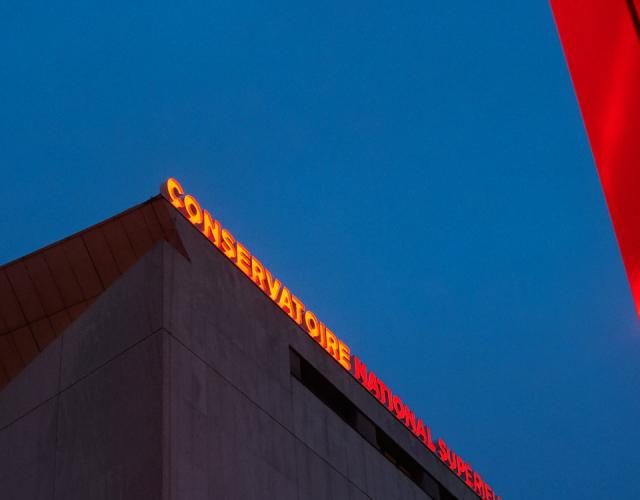
Choreographic accompaniment - 1er Cycle
Information
-
Name
Choreographic accompaniment
-
Cycle
1st Cycle
-
Course's number of years
3 years
-
Maximum duration
3 years
Students in the first and second years of the1st cycle who feel that they can complete the Diplôme de1er cycle supérieur at the end of the current school year may sit the final examination for the Diplôme de1er cycle supérieur at the end of the first or second year instead of the final examination; if they fail the examination and/or do not validate all the disciplines attached to the Diplôme de1er cycle supérieur, they must continue their studies in the upper year of the1st cycle and sit the final examination for the Diplôme de1er cycle supérieur again.
-
ECTS
180
-
Delivered diploma
Diplôme de1er cycle supérieur d'Accompagnement chorégraphique (1st cycle Advanced Diploma in Choreographic Accompaniment)
The distinction (Très bien, Bien or Assez bien) qualifying the Diplôme de1er cycle supérieur is that awarded by the jury at the end of the final examination of the1er cycle supérieur.
The Diplôme de1er cycle supérieur d'Accompagnement chorégraphique is also awarded to students who did not obtain a distinction in the final examination of the1st cycle supérieur but whose results in the 1st and2nd year examinations so permit, in accordance with the procedures described in Title I - article 5 of the study regulations.
-
Course objectives and content
Training in the specific techniques of dance accompaniment.
Preparation for a career as a pianist accompanying dance classes and choreographic performances.
Practising improvisation within a framework structured by dance, for pianists of an excellent level who have practised improvisation.
Development of the personal musical aesthetic of dance accompanists.
Deciphering movement as a musical pattern.
Analysis of the relationship between music and dance.
Learning to improvise structured by a carrure or bodily proposal.
Study of the dance repertoire.
Placement in classical and contemporary dance classes.
The Diplôme de1er cycle supérieur d'Accompagnement chorégraphique is awarded to students who have obtained all of the following awards :
ECTS the1st cycle advanced certificate in choreographic accompaniment 134 the 5 specific attestations :
- attestation n° 1 - accompaniment at the beginning of a dance class
- attestation n° 2 - accompanying a dance class
- attestation n° 3 - workshop work
- certificate no. 4 - personal project
- certificate no. 5 - accompaniment of a repertoire class
10 analysis A or B 8 introduction to the history of dance 8 introduction to keyboard harmonisation A or B or introduction to writing A or B 8 modern language 3 practical aspects of the profession 1 and 2 1 professional situations 4 a certificate or attestation in a complementary optional subject of your choice*. 4 * Students are strongly advised to opt for the 'Introduction to improvisation' option.
-
French language certificate
B1
-
Bachelor's degree
A partnership between the Conservatoire national supérieur de musique et de danse de Paris and Sorbonne-Université enables Conservatoire students who so wish, and who are admitted to the 1st cycle, to obtain, together with the Conservatoire's 1st cycle diploma, and subject to fulfilling the conditions for enrolment at the university, the Bachelor degree of Music and Musicology from Sorbonne-Université, including the Diplôme National Supérieur Professionnel de Musicien (DNSPM) from the CNSMDP, and validation at the university of four 26-hour courses, spread over four semesters, chosen from the "Domaines musicologiques" teaching units.
Students are free to choose at which stage of their studies at the Conservatoire (1st or 2nd cycle) they wish to begin this university course.
Registration and payment of university fees are required to follow the courses. -
Number of complementary disciplines to validate
1
Disciplines
Entrance exam
Choreographic accompaniment (undergraduate)
Opening date for registration : 10 October 2025
Closing date for registration : 14 November 2025
Exam dates : Mercredi 4 mars 2026
Visa
Non-EU candidates must apply for a short-stay “competition” visa in order to take part in the entrance examinations. If successful, this visa will then allow you to apply for a student visa. You should not apply for a tourist visa. More information here
French Language Level
Successful candidates who are not nationals of French-speaking countries must present upon first enrollment: a French language certificate (DELF or TCF) at level B1 or higher.
Declaration of Principal Instrument
Candidates must declare a principal instrument (piano or percussion) at the time of their application.
Audition
Admissibility
1. One required work (principal instrument*), set pieces announced January 10
2. One work of the candidate’s choice from List A (principal instrument*), set pieces announced January 10
For percussionists only:
3. One required work (on piano), set pieces announced January 10
4. One work (or excerpt) for solo piano of the candidate’s choice (maximum 4 minutes)**
For all candidates:
5. Sight-reading, preceded by a short preparation in a practice room***
* For percussionists, admissibility test no. 1 is performed on drums, and the list for test no. 2 includes works for drums and keyboard instruments.
** For test no. 4, the style of the work is at the candidate’s discretion (classical, romantic, 20th or 21st century repertoire, jazz standard, etc.).
*** For pianists, sight-reading is performed at the piano; for percussionists, it is performed on keyboard instruments.
Candidates holding a DNSPM in piano or percussion are exempt from tests 1 and 2.
Admission
-
Improvisation based on a musical theme and/or given instructions (4–5 minutes)
-
Directed improvisation exercises (10 minutes)
-
Interview (5–10 minutes)
A 15-minute preparation in a practice room precedes the admission tests.
Directed Improvisation Test
The candidate must improvise according to constraints given live by a jury member. Evaluation focuses on:
-
Ability to maintain a steady tempo
-
Ability to modulate tempo (accelerate, slow down, progressively or suddenly)
-
Ability to maintain a constrained rhythmic framework (irregular measures, emphasis on a specific beat, etc.)
-
Ability to construct cycles with imposed bar structures
-
Ability to create an inventive and contextually appropriate sonic imagination
Maximum age : 28
